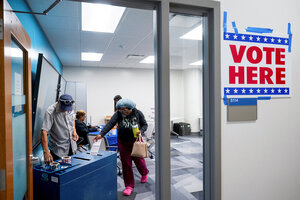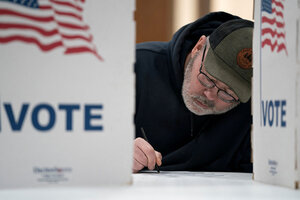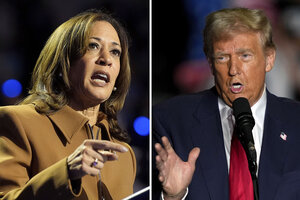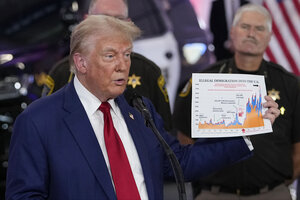Here’s what it looks like when voting goes right
| Charlotte, North Carolina
Hours after the polls had closed in North Carolina, there were traces of blue and red in the uptown skyline. Multicolored lights were draped near the top of the Truist Center skyscraper, and depending on your perspective, the TRUIST marquee almost looked like a prediction for the GOP nominee.
Meanwhile, the Mecklenburg County Board of Elections building looked like uptown Charlotte during rush hour. There were cars streaming in and out, dropping off bags and ballots. Even as major news outlets were poised to announce North Carolina’s winner, these champions of democracy were still at work.
At the center of it all was a steady hand – the BOE’s Public Information Director, Kristin Mavromatis, who has worked in this space since 1996.
“It’s still a thrill for us, but this isn’t my first rodeo,” Ms. Mavromatis said with a confident smile. “I’ve been here since 4 a.m. … I wish people would do this at every election, not just the presidential election.”
Part of that excitement might have been precarious, if the 2020 presidential election was any indication. It was a time of conspiracy theories and election intimidation that left elections officials on edge. And there was always that possibility this time, too. The fact that Mr. Trump won – and handily – undercut potential narratives of conspiracy and fraud.
Instead, this election was allowed to be what it was: A reminder of the remarkable process that fuels American elections without bias –and the remarkable men and women who make that possible. The Mecklenburg County Board of Elections building was just one of the hundreds of places across the country that made sure voters’ voices were heard.
Thankfully, Tuesday night was a lot more calm than 2020.
“We had some security at certain precincts, and we heard rumors that people left because they didn’t feel comfortable with the police being there. This is the South,” said Ms. Mavromatis. “But all in all, this was a great day and nothing like 2020. I’m thankful and grateful.
“Yeah, 2020 was bad. ... It was a different time,” she added. “This seemed to head back to a place where we didn’t have the hostility among people, and we’ll just leave it at that.”
Somewhere in this democratic – and oxymoronic – mix of routineness and uncertainty, there was room for newness. As a host of bright red bags were hoisted onto a nearby desk, one of the election workers on hand yelled, “Eleven!” It wasn’t a bingo game, but there was a large list with numbers of all of the precincts. It was volunteer Ghazala Johnston’s responsibility to mark off all 196 precincts as they came in.
“I had a fun job,” she said.
Ms. Johnston, an Iranian-American, was inspired to help at the Board of Elections because of the canvassing she sees every election season.
“Any time I go into a [campaign] and I see all of the people working there, I’m kind of inspired by them because they’re all committed to the job they have,” Ms. Johnston said. “And I always kind of leave thinking, ‘Oh, that would be kind of cool.’”
“You’re interacting with people, you’re promoting democracy, you’re doing a really cool civic duty,” she added. “This time, I said, instead of talking about it, I’m gonna actually do something.”
She wanted to help out at the polling sites, but her schedule conflicted with the training dates. Fortunately, another opportunity opened up at the main hub.
“My family and I were immigrants. They came to America when I was 2 years old, so I take a lot of pride in voting,” she said. “Being on this side and supporting the democratic process seemed kind of exciting and cool to do. ... I would do it again.”















